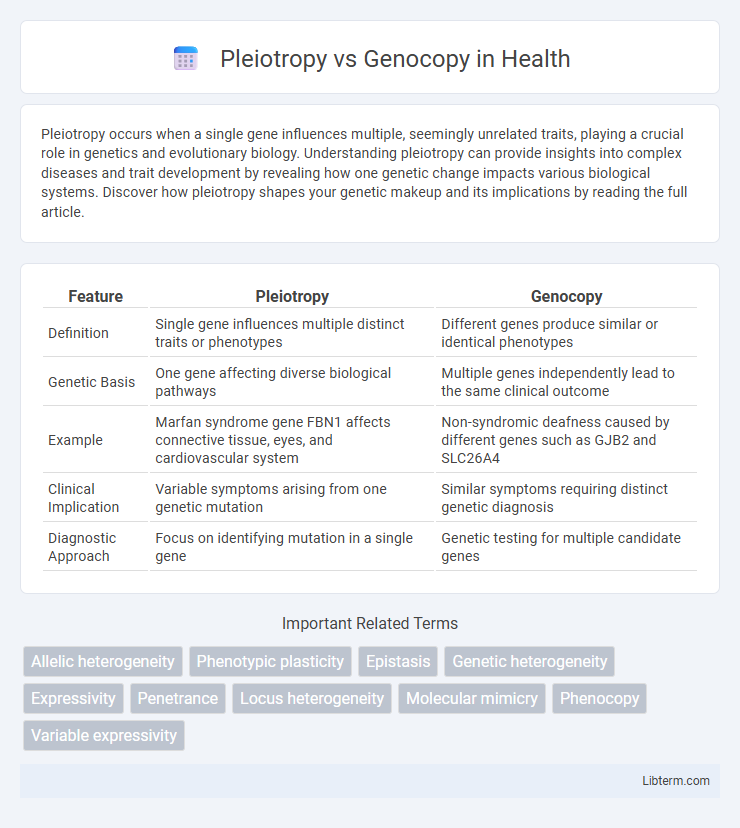Pleiotropy occurs when a single gene influences multiple, seemingly unrelated traits, playing a crucial role in genetics and evolutionary biology. Understanding pleiotropy can provide insights into complex diseases and trait development by revealing how one genetic change impacts various biological systems. Discover how pleiotropy shapes your genetic makeup and its implications by reading the full article.
Table of Comparison
| Feature | Pleiotropy | Genocopy |
|---|---|---|
| Definition | Single gene influences multiple distinct traits or phenotypes | Different genes produce similar or identical phenotypes |
| Genetic Basis | One gene affecting diverse biological pathways | Multiple genes independently lead to the same clinical outcome |
| Example | Marfan syndrome gene FBN1 affects connective tissue, eyes, and cardiovascular system | Non-syndromic deafness caused by different genes such as GJB2 and SLC26A4 |
| Clinical Implication | Variable symptoms arising from one genetic mutation | Similar symptoms requiring distinct genetic diagnosis |
| Diagnostic Approach | Focus on identifying mutation in a single gene | Genetic testing for multiple candidate genes |
Understanding Pleiotropy: A Basic Overview
Pleiotropy occurs when a single gene influences multiple phenotypic traits, demonstrating the gene's diverse effects on an organism's biology. This genetic phenomenon contrasts with genocopy, where different genes produce similar phenotypes despite distinct genetic origins. Understanding pleiotropy is crucial for studying complex traits and diseases, as one genetic mutation can impact various physiological systems simultaneously.
Genocopy Explained: Definition and Significance
Genocopy refers to a phenotype caused by environmental factors or different genetic mutations that mimic the appearance of a genetically inherited trait. This concept is significant in genetics because it highlights how non-genetic influences or alternative genetic pathways can produce similar observable characteristics, complicating the interpretation of hereditary patterns. Understanding genocopy aids researchers and clinicians in accurately diagnosing genetic conditions and distinguishing them from phenocopies or direct genetic mutations like pleiotropy.
Key Differences Between Pleiotropy and Genocopy
Pleiotropy occurs when a single gene influences multiple phenotypic traits, whereas genocopy involves different genes producing the same phenotype. The key difference lies in the genetic origin: pleiotropy stems from one gene affecting various traits, while genocopy results from distinct genes causing phenotypic similarity. Understanding this distinction helps in genetic diagnosis and research, as pleiotropic effects indicate gene multifunctionality, whereas genocopy highlights genetic heterogeneity.
Genetic Mechanisms Underlying Pleiotropy
Pleiotropy occurs when a single gene influences multiple phenotypic traits through diverse molecular pathways, reflecting genetic mechanisms such as gene product multifunctionality and regulatory gene networks. Genetic pleiotropy often results from one gene encoding a protein involved in various biological processes or interacting with different cellular components, leading to wide-ranging phenotypic effects. In contrast, genocopy involves different genes producing similar phenotypes, highlighting distinct genetic origins rather than pleiotropic influence.
How Genocopy Mimics Phenotypes: Genetic Pathways
Genocopy mimics phenotypes by involving distinct genetic pathways that produce similar observable traits despite different underlying mutations. Unlike pleiotropy, where a single gene influences multiple traits, genocopy arises when different genes act in parallel or convergent pathways, leading to phenotypic overlap. Understanding the divergent genetic routes in genocopy enhances insights into complex trait manifestations and diagnostic challenges in genetic disorders.
Clinical Examples of Pleiotropy in Human Diseases
Pleiotropy occurs when a single gene influences multiple phenotypic traits, as seen in Marfan syndrome where mutations in the FBN1 gene impact connective tissue, leading to cardiovascular, ocular, and skeletal abnormalities. In contrast, genocopy refers to different genetic mutations producing similar phenotypes, such as retinitis pigmentosa caused by various gene mutations but resulting in progressive vision loss. Clinical examples of pleiotropy highlight the complexity of genetic disorders and the necessity for comprehensive diagnostic approaches in precision medicine.
Notable Cases of Genocopy in Medical Genetics
Notable cases of genocopy in medical genetics include phenylketonuria (PKU), where genetic mutations mimic symptoms of environmental deficiencies despite differing etiologies. Another example is hereditary hemochromatosis, which phenotypically resembles secondary iron overload caused by repeated blood transfusions. These genocopies complicate diagnosis due to their phenotypic similarity to other genetic or acquired conditions, highlighting the importance of genetic testing for accurate clinical classification.
Diagnostic Challenges: Distinguishing Pleiotropy from Genocopy
Distinguishing pleiotropy from genocopy presents diagnostic challenges due to overlapping phenotypic traits caused by different genetic mechanisms. Pleiotropy involves a single gene influencing multiple phenotypic traits, whereas genocopy results from different genes producing similar clinical presentations. Accurate molecular genetic testing and comprehensive phenotype-genotype correlation are essential to differentiate these conditions and guide precise diagnosis and treatment planning.
Implications for Genetic Counseling and Precision Medicine
Pleiotropy, where a single gene influences multiple phenotypic traits, poses challenges for genetic counseling by complicating risk assessment and phenotype prediction, necessitating comprehensive family history analysis and personalized risk communication. Genocopy, involving different genotypes producing similar phenotypes, underscores the importance of precise molecular diagnosis in precision medicine to avoid misdiagnosis and guide targeted therapies effectively. Understanding these genetic concepts enhances the development of tailored prevention strategies and therapeutic interventions, improving patient outcomes in clinical genetics.
Future Research Directions in Pleiotropy and Genocopy
Future research in pleiotropy and genocopy will leverage advanced genomic technologies such as single-cell sequencing and CRISPR-Cas9 gene editing to unravel complex gene-phenotype relationships. Integrative multi-omics approaches combined with large-scale biobank data will enhance understanding of how single genes contribute to multiple phenotypes and mimic distinct genetic conditions. Machine learning algorithms applied to genotype-phenotype datasets will accelerate the identification of novel pleiotropic effects and genocopies, facilitating precision medicine strategies.
Pleiotropy Infographic

 libterm.com
libterm.com